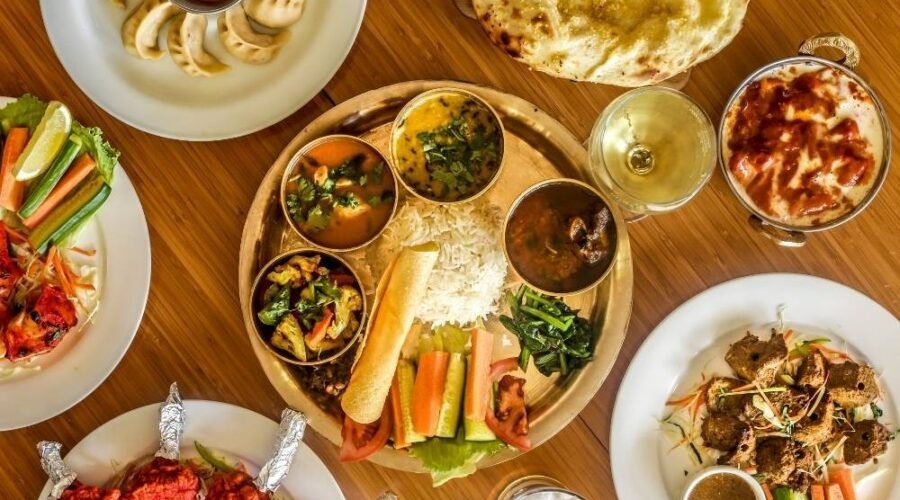Nepali Cuisine: A Culinary Journey Through Local Flavors
Nepali cuisine is a celebration of flavors, spices, and culinary traditions shaped by the country’s diverse geography and culture. Nestled between India and China, Nepal’s food reflects a unique blend of influences while retaining its distinct identity. From the Himalayan highlands to the Terai plains, every region offers a taste of its heritage. Join us on a culinary journey through the flavors of Nepal.
Dal Bhat: The Heart of Nepali Cuisine
No discussion of Nepali food is complete without mentioning dal bhat. This quintessential dish consists of steamed rice (bhat) served with lentil soup (dal), complemented by a variety of accompaniments like:
- Tarkari: Seasonal vegetable curry.
- Achar: Spicy pickles or chutneys.
- Gundruk: Fermented leafy greens, a Nepali delicacy.
- Meat Curry: Often goat, chicken, or buffalo, especially during festivals.
Dal bhat isn’t just a meal; it’s a way of life for Nepali people, offering sustenance and energy for their active lifestyles.
Momo: Nepal’s Beloved Dumplings
Momo, a Tibetan-inspired dish, has become a culinary staple across Nepal. These bite-sized dumplings are filled with minced meat, vegetables, or cheese and served with a tangy dipping sauce (achar). Momos come in various forms:
- Steamed: The classic preparation.
- Fried: Crispy and golden.
- Jhol Momo: Served in a spicy, soupy broth.
Whether enjoyed as a snack or a meal, momos are loved by locals and visitors alike.
Sel Roti: A Festive Delight
Sel roti, a traditional Nepali sweet bread, is a must-try during festivals like Dashain and Tihar. Made from rice flour and deep-fried into a circular shape, sel roti is crispy on the outside and soft inside. It pairs perfectly with alu achar (potato pickle) or a cup of tea.
Dhido: A Taste of Tradition
For a truly authentic experience, try dhido, a traditional dish made from buckwheat or millet flour. This thick, porridge-like food is eaten with a variety of sides, such as meat, vegetable curry, or gundruk soup. Dhido is a staple in rural areas and cherished for its health benefits and simplicity.
Newari Cuisine: A Feast of Flavors
The Newar community of the Kathmandu Valley boasts a rich culinary heritage. Their food is known for its bold flavors and intricate preparation. Highlights include:
- Yomari: Sweet dumplings filled with molasses and sesame seeds.
- Bara: Lentil pancakes, often topped with eggs or minced meat.
- Samay Baji: A ceremonial platter featuring beaten rice, buffalo meat, spiced potatoes, and pickles.
- Chhoila: Grilled and spiced buffalo meat.
Newari cuisine reflects the community’s deep connection to tradition and celebration.
Thakali Cuisine: A Gastronomic Experience
Originating from the Thak Khola region, Thakali cuisine is famous for its balanced flavors and presentation. A typical Thakali meal includes:
- Lentils, rice, and ghee.
- A variety of vegetable curries.
- Achar, often made from tomatoes and sesame seeds.
- Meat, particularly slow-cooked mutton.
Thakali food is a perfect representation of simplicity meeting sophistication.
Street Food: A Burst of Flavor
Nepal’s street food scene is vibrant and irresistible. Popular snacks include:
- Pani Puri: Crisp hollow puris filled with tangy tamarind water.
- Chatpate: A spicy, tangy mixture of puffed rice, potatoes, and chutneys.
- Sekuwa: Grilled and spiced meat skewers, often enjoyed with a cold drink.
Street food in Nepal offers an explosion of flavors for adventurous eaters.
Beverages: Sip and Savor
No culinary journey is complete without sampling Nepali beverages. Popular choices include:
- Chiyaa: Sweet, spiced milk tea.
- Tongba: A warm millet-based alcoholic drink, perfect for cold Himalayan nights.
- Raksi: Traditional distilled liquor, often served during celebrations.
Conclusion
Nepali cuisine is a testament to the country’s rich cultural tapestry and natural bounty. Whether you’re indulging in a hearty plate of dal bhat, savoring momos, or exploring regional specialties, every bite tells a story. So, the next time you visit Nepal, let your taste buds embark on their own adventure—you’ll discover that food here is not just sustenance but an integral part of life and celebration.




